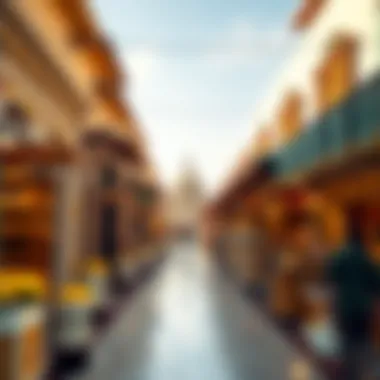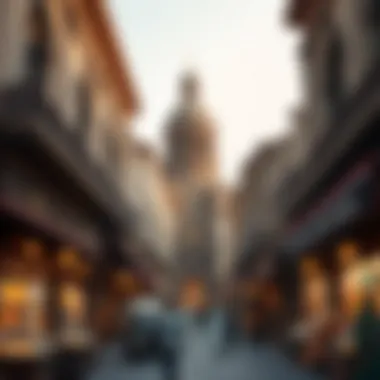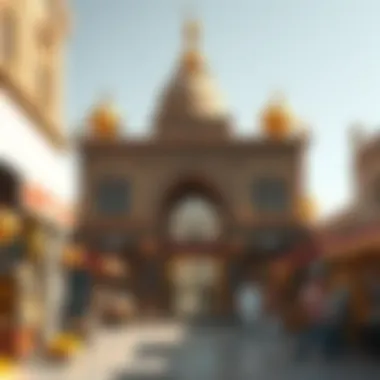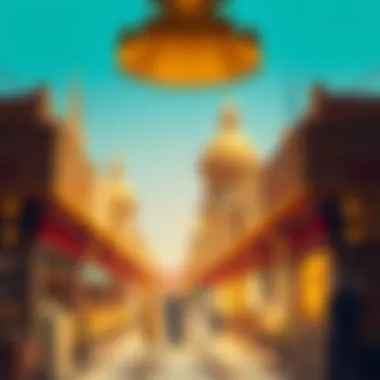Exploring Dubai's Gold Souk and Meena Bazaar


Intro
Dubai's markets are more than just a place to shop. They are a tapestry of culture, history, and economics woven together over the years. Two markets that capture this essence with distinct flair are Gold Souk and Meena Bazaar. Gold Souk, with its glittering displays of precious metals, attracts not only locals but also tourists looking for that perfect piece of jewelry. It's a realm where craftsmanship meets opulence, and every shop tells a story.
On the flip side lies Meena Bazaar, bustling with activity and vibrant textiles. This market showcases the rich cultural heritage of Dubai, offering everything from traditional attire to aromatic spices. The contrast between the two markets reflects the social dynamics of the area, fascinating in its complexity. As you stroll through these spaces, it’s evident that they are vital organs in the body of Dubai’s economy, shaping community life and influencing real estate trends.
This article aims to delve into the depths of these marketplaces, exploring their history, relevance, and impact on the local economy. By understanding these markets, we gain insights into the broader economic landscape of Dubai, something especially valuable for investors, expats, and anyone interested in the real estate scene. Let’s take a closer look at the market dynamics at play as we embark on this journey from Gold Souk to Meena Bazaar.
Market Trends
Current Market Analysis
In recent years, both Gold Souk and Meena Bazaar have shown a robust pattern of growth. The opulence of Gold Souk has attracted high-net-worth individuals seeking investment opportunities in gold and jewelry. Meanwhile, Meena Bazaar serves as a hub for cultural exchanges, drawing in people from various backgrounds who contribute to its diversity.
- Gold Souk: The price of gold has fluctuated but generally maintains high demand due to both local and international purchases. With its winding alleys, shopping for gold here is not merely transactional; it’s an experience. The ambiance and the array of choices make it worth any visitor's while.
- Meena Bazaar: Goods here range widely, from pashmina shawls to intricate henna designs. This market has become increasingly popular among expatriates, with many seeking authentic cultural items that resonate with their heritage.
Both these markets demonstrate resilience in the face of economic changes, adapting to attract both locals and tourists.
Future Projections
Looking ahead, the future of these marketplaces seems promising. Analysts foresee an increase in foot traffic, especially as global travel restrictions lessen and tourism rebounds.
- Gold Souk: Experts predict a possible rise in gold prices, further enhancing its allure for investors. Emerging trends indicate a growing interest in ethical gold sourcing, which could reshape how retailers operate in the area.
- Meena Bazaar: The expansion of online retailing poses a challenge but also an opportunity. The market may leverage its cultural richness by incorporating online platforms for greater outreach without losing the personal touch that physical interaction offers.
As the landscape changes, both marketplaces will continue to be pivotal in shaping Dubai's eclectic blend of tradition and modernity.
Historical Context of Dubai's Markets
The landscape of Dubai's markets tells a story steeped in culture and commerce. Understanding the historical context of these traditional marketplaces is crucial, as it provides a lens through which we can appreciate their significance in today's fast-paced society. The Gold Souk and Meena Bazaar serve not merely as shopping destinations. They are vibrant cultural hubs that reflect the evolution of trade, the socio-economic fabric, and the enduring traditions of this dynamic city.
The Evolution of Trade in Dubai
Dubai's trading history began as a simple exchange of goods, rooted in the region’s strategic position along ancient trade routes. In the early days, merchants would traverse the desert, while maritime trade flourished in the waters of the Persian Gulf. These early traders brought spices, textiles, and pearls, establishing the city as a focal point for diverse economies.
Over the decades, trade activities grew more sophisticated. By the 20th century, the discovery of oil transformed the economic landscape dramatically. This wealth allowed Dubai to invest in infrastructure, from roads to marketplaces, paving the way for modern retail environments. Today, the gradual shift from traditional barter systems to contemporary commercial practices is evident in both the Gold Souk, with its glimmering gold shops, and Meena Bazaar, where textiles and artisan goods come to life.
- Key Developments in Trade:
- Establishment of the Dubai Chamber of Commerce in 1965.
- Creation of Free Trade Zones to encourage foreign investment.
- Hosting of expos and trade fairs, elevating Dubai’s global status.
Each phase of this evolution has contributed to a vibrant market scene that attracts tourists and locals alike, sparking curiosity about the past and respect for local traditions.
Significance of Gold Trading in Dubai
Gold trading holds a unique position in Dubai's marketplace narrative, entwined with the city’s identity. The Gold Souk is often dubbed the ‘city of gold,’ a testament to its status as a major trading hub for the precious metal. The art of gold craftsmanship extends beyond commerce; it symbolizes wealth, love, and cultural heritage.
- Cultural Reverence: Gold is not simply a material possession; it plays a profound role in weddings, religious ceremonies, and family heirlooms throughout Middle Eastern culture.
- Economic Indicator: The market fluctuations of gold prices often reflect the larger economic environment. Investors keep a close watch on these trends, knowing that the price of gold can be an indicator of the city's economic health.
- Tourist Attraction: The Gold Souk draws a high volume of tourists who wish to purchase gold jewelry. It serves as both a shopping destination and a cultural experience, merging modern consumerism with rich tradition.
"The Gold Souk represents the heart of Dubai's marketplace. It’s not just about trading gold; it’s about trading stories, heritage, and aspirations."
Thus, the significance of gold trading in Dubai extends beyond mere transactions. It represents a synthesis of history, culture, and economic strategy that has shaped the market scene as we see it today.
Overview of the Gold Souk
The Gold Souk is not just a cluster of shops; it stands as a beacon in Dubai's vibrant marketplace scene. This iconic trading hub draws both locals and tourists from all corners of the globe, reflecting a lasting tradition that marries commerce with culture. The significance of this souk extends beyond mere transactions. It's a space where the glimmer of gold intertwines with local heritage, transforming shopping into a rich sensory experience.
Design and Layout of the Souk


Stepping into the Gold Souk is akin to entering a kaleidoscope of luxury. The narrow alleyways are lined with dazzling displays of gold jewelry, creating a tapestry of glimmering pieces that captivate every passerby. The architecture, while reflecting the historic roots of Dubai, showcases modern influences, providing both shade from the sun and an inviting atmosphere.
- Canopied Walkways: The souk is designed with arched roofs that offer shelter from the typically warm Dubai climate, making it comfortable for visitors.
- Stall Organization: Shops are closely knit, each vying for attention with their stunning window displays. Over forty retailers, all specializing in varied gold settings—ranging from intricate traditional designs to contemporary chic.
- Social Hub: This design encourages interaction among shoppers, fostering an active buzz that enhances the shopping experience.
Types of Gold Available
One of the fascinating aspects of the Gold Souk is the diversity of gold types on offer. Visitors can find:
- 24K Gold: Often seen as the purest form, it is prevalent among customers seeking investment pieces.
- 18K Gold and 22K Gold: These are perfect for those looking for durability alongside beauty, as they balance quality with aesthetic.
- Unique Designs: Traditional Emirati designs stand side by side with modern creations, catering to varied tastes and preferences.
This wide array means that anyone stepping into the souk is likely to find something that piques their interest, whether for personal adornment or as a treasured gift.
Cultural Practices Surrounding Gold Purchasing
Gold purchasing at the souk is steeped in cultural significance. It’s not just about buying a piece of jewelry; it’s often about rituals and community ties.
- Negotiation: Bargaining is an accepted practice here, with customers and traders engaging in playful yet serious back-and-forth over prices. It’s seen less as haggling and more as part of the experience.
- Gift-Giving Traditions: Gold is commonly gifted at weddings and other significant life events, making the act of purchasing deeply intertwined with family customs.
- Symbol of Status: In many Middle Eastern cultures, owning gold is seen as a status symbol, reflecting wealth and esteem within the community.
Gold Souk thus embodies the essence of commerce layered with rich cultural practices, making it a microcosm of the broader Dubai ethos, thriving on tradition while embracing modernity.
The Gold Souk is not merely a market; it’s a cultural narrative of a city that has successfully blended the past with the present.
Overview of Meena Bazaar
Meena Bazaar represents more than just a collection of shops; it embodies the essence of cultural diversity and commercial vibrancy that Dubai is renowned for. Nestled amidst the bustling streets, this marketplace functions as a bridge linking various traditions, stories, and communities through its layout and offerings. In this section, we will delve into its architectural features, the diverse textiles and goods available, and the critical role it plays in cultural exchange.
Architectural Features of the Bazaar
The architectural design of Meena Bazaar narrates its historical significance and cultural impact. The bazaar features a blend of traditional Arabian motifs with modern influences, creating a vibrant tapestry that is visually appealing. You’ll find intricately designed arches, narrow alleyways, and shops that draw on intricate tile work and hand-carved wooden elements.
This blending of styles is more than aesthetic; it reflects the melting pot of cultures that Dubai hosts. As such, the architecture is not only functional but also symbolic. Each stall and corner radiates stories of the past while accommodating the necessities of contemporary commercial needs.
Additionally, the bazaar's layout encourages exploration. Visitors easily lose track of time, wandering through alleys adorned with colorful fabrics and handcrafted goods. The use of glass storefronts allows natural light to illuminate the goods on display, inviting shoppers deeper into the market's embrace. It's a physically and metaphorically structured journey; each turn reveals something new, a testament to the bazaar's dynamic nature.
Diverse Textiles and Goods Offered
One of the key attractions of Meena Bazaar is its extensive array of textiles and goods, which cater to a variety of tastes and preferences. Here, you'd find everything from silks and cotton to intricate embroidery and traditional attire like kaftans and abayas.
Visitors often marvel at the dizzying opulence of colors and patterns. The bazaar houses shops that specialize in:
- Ethnic UAE attire: Vibrant thobes and stunning abayas that speak to tradition.
- Textiles from across the globe: Fabrics brought from places like India, Pakistan, and other Asian countries.
- Cultural artifacts: Handmade crafts, jewelry, and accessories that serve as perfect souvenirs.
This variety not only satisfies individual shoppers but also serves the needs of businesses looking to source materials or products. It's a one-stop shop for anyone wanting to capture the essence of Dubai's multicultural fabric through its goods.
Role of Cultural Exchange in Meena Bazaar
Beyond commerce, Meena Bazaar is a flourishing hub for cultural exchange. It acts as a meeting place where expats and locals coalesce, fostering an environment teeming with collaboration and mutual respect. The bazaar threads connections between different nationalities, encouraging open dialogues and cultural appreciation.
Events and festivals often take place here, enhancing this cultural exchange even further. For instance, during Ramadan, the bazaar buzzes with evening shoppers as special cultural displays and food stalls pop up, inviting everyone to partake in the festive atmosphere. These happenings create shared experiences and foster relationships among different communities and cultures—making the bazaar a microcosm of Dubai's spirit.
In summary, Meena Bazaar stands as a compelling example of how traditional markets can bridge cultural divides while functioning as economic drivers. The intricate architecture, diverse textile offerings, and rich cultural exchanges make it a unique centerpiece in Dubai's marketplace landscape.
Comparative Analysis: Gold Souk vs. Meena Bazaar
The comparison between Gold Souk and Meena Bazaar serves as a fascinating lens through which we can understand the intricacies of Dubai's marketplace dynamics. On the surface, these two hubs may appear quite different: one is a glimmering showcase of gold, while the other thrives on vibrant textiles and spices. However, a deeper examination reveals that they both fulfill essential social and economic roles within the city and attract a shared, yet diverse, audience.
Target Demographics of Each Market


Negotiating the bustling lanes of either market offers a glimpse into the myriad of individuals who flock to them. The Gold Souk primarily attracts buyers looking for investment pieces or gifts steeped in cultural significance; often, these customers are affluent tourists or residents with specific tastes in gold.
In contrast, Meena Bazaar serves as a melting pot catering to a wider demographic that ranges from expansive local families to expats seeking unique textiles or authentic spices. Here, shoppers transcend financial boundaries, as the offerings suit varying budgets. Some notables of the Meena Bazaar crowd include visitors aiming to discover more about local craftsmanship or culinary ingredients, all while soaking in the lively atmosphere.
Key Demographics:
- Gold Souk:
- Meena Bazaar:
- Wealthy tourists
- Local jewelers and traders
- Residents seeking gifts or investment pieces
- Expat families
- Local shoppers
- Tourists interested in cultural experiences
Shopping Experiences and Customer Engagement
Shopping in both venues offers distinctive experiences and levels of engagement. At the Gold Souk, the atmosphere is often formal and focused. Transactions tend to be more serious, centered around negotiating prices and assessing the quality of gold. Vendors showcase their products with precision, appealing to customers who require more than just a pretty piece of jewelry.
In contrast, the ambiance in Meena Bazaar is lively and informal, akin to a tapestry woven with chatter and laughter. Shoppers meander through a vibrant maze of stalls, often engaging in spirited conversations with merchants about the origins of their products or the nuances of cultural traditions. The diversity of goods — from intricate textiles to aromatic spices — encourages an exploratory shopping experience that is both tactile and sensory.
Shopping Experience Characteristics:
- Gold Souk:
- Meena Bazaar:
- Focused and formal
- Strong emphasis on product quality and price negotiation
- Engaging interactions mainly centered around product details
- Lively, vibrant atmosphere
- Exploration leads to immersion in local culture
- Engaging customer experiences bolstered by interactive discussions
Both areas create unique shopping experiences rooted in their respective offerings, attracting diverse groups of individuals eager for distinct cultural interactions. While the Gold Souk embodies prestige and tradition, Meena Bazaar offers a delightful exploration into the heart of local culture. Understanding these contrasts can illuminate the myriad ways that Dubai maintains its rich tapestry of commerce, inviting locals and visitors alike to partake in its markets.
Economic Impact of the Markets
The economic impact of traditional markets like the Gold Souk and Meena Bazaar in Dubai can’t be overstated. These marketplaces are more than just places to buy goods; they're vital components of the city’s economy. They influence property values, attract tourists, and provide many jobs. As the bustling city of Dubai continues to grow, understanding the economic significance of its markets provides insights into the overall health and direction of the local economy.
Contributions to Dubai’s Economy
The Gold Souk and Meena Bazaar contribute significantly to Dubai’s economy in various ways. These markets bring in substantial revenue through both local sales and tourism. Tourists flock to these hubs to experience the local culture, with the Gold Souk known for its stunning gold jewelry and Meena Bazaar celebrated for its rich textiles.
- Tourist Attraction: The Gold Souk and Meena Bazaar attract millions of visitors yearly, making them a primary source of income for Dubai. Tourists shopping for gifts or mementos contribute to high sales figures, boosting the economy.
- Sales Tax Revenue: Every transaction at these markets generates tax revenue for the city. The VAT implemented in the UAE has a noticeable effect on local trading, providing much-needed funds for public services.
- Cultural Preservation: The Gold Souk and Meena Bazaar are also crucial in preserving and promoting Emirati culture, which in itself is a draw for tourists. A vibrant market scene enriches the cultural tapestry of Dubai, making it more appealing to visitors.
"These markets are more than sales points but are critical to the cultural and economic identity of Dubai."
- Investor Interest: As these markets thrive, they foster interest from investors looking to tap into the local trade opportunities. This influx of capital contributes to further market development and expansion.
Employment Opportunities Created
The markets not only enhance Dubai’s economic growth but also play a crucial role in providing employment opportunities.
- Direct Employment: Thousands of individuals work directly in these markets, in various roles ranging from sales to management. Shops in the Gold Souk employ artisans who create bespoke jewelry, while Meena Bazaar has a plethora of shopkeepers and textile workers.
- Supporting Industries: Beyond direct employment, these markets also support ancillary industries, like logistics, advertising, and service industries. For instance, transporting goods to and from these marketplaces creates opportunities for drivers and warehouse staff.
- Cultural Enrichment Jobs: Local artisans and craftsmen find their place in these markets by offering traditional goods, while cultural performances often happen in and around these locations. This employment not only supports families but also keeps the local traditions alive.
- Vocational Training: With the growth of these bustling centers comes the need for training programs. Local initiatives provide vocational training for individuals aiming to join the workforce, thus contributing to skill development in the community.
In summary, the Gold Souk and Meena Bazaar are dynamic marketplaces that significantly impact Dubai's economy. Through direct and indirect job creation and immense tourist attraction, these markets help shape the economy while also serving as symbols of the region's rich cultural heritage.
Real Estate Implications of the Markets
The interrelationship between traditional markets like the Gold Souk and Meena Bazaar and real estate forms an intriguing aspect of Dubai's economic tapestry. This goes beyond mere property values; it’s basically about how proximity to these vibrant centers can shape a community's pulse. As people flock to the souks for both business and leisure, the surrounding real estate landscapes transform, becoming hot commodities that attract investors and renters alike.
The accessibility and attractiveness of these markets play a role in determining property prices. Most buyers and renters naturally look for locations that offer a mix of culture, convenience, and vibrancy. For example, properties near the Gold Souk often command higher rents, thanks to a constant stream of both tourists and locals keen on gold jewelry and precious stones. The same goes for Meena Bazaar, which attracts individuals from various backgrounds, keen on exploring textiles and local delicacies. The increased foot traffic elevates not just the market areas but the nearby residential and commercial properties as well.
Property Values in Proximity to the Souk


In terms of property values, locations near the Gold Souk are often scrutinized with a magnifying glass. According to real estate experts, the neighborhood's appeal can lead to inflated property prices. Buyers are inclined to invest in apartments and shops that promise high visibility and footfall. The current trend shows favorable appreciation rates in property values adjacent to these markets, making them lucrative for future investments.
This phenomenon usually is linked to a few key factors:
- High Demand: As the Gold Souk continues to attract tourists and locals, the demand for housing nearby increases consistently.
- Amenities and Infrastructure: The vibrant commercial activity leads to better infrastructure and amenities in the vicinity, enhancing the overall attractiveness of the area.
- Cultural Experience: Living close to such culturally rich markets offers a unique experience that many find appealing. People enjoy the ability to seamlessly blend their daily lives with cultural exploration.
In many cases, close proximity to the souks not only increases property values, but also draws in businesses seeking to capitalize on the foot traffic. Investors who look at these trends tend to bring in more commercial opportunities, which in turn raises the stake for residential properties as well.
Impact on Local Businesses and Development
The presence of the Gold Souk and Meena Bazaar can catalyze local businesses, spurring a cycle of development and innovation. Shops in the immediate vicinity often benefit from the spillover of customers drawn to the markets. This, naturally, leads to an increase in customer base for several sectors, including dining, retail, and services. Investors see potential here, as the rising tide lifts all boats—businesses thrive and property values are strengthened simultaneously.
Local entrepreneurs are inclined to set up shop, knowing that foot traffic from markets fuel their potential customer base. Moreover, such commercial growth also encourages stakeholders to enhance the urban landscape. Local governments may invest in cleaner streets, better signage, and even cultural programs, all of which elevate the neighborhood.
If you consider the implications thoroughly, it’s quite clear that the Gold Souk and Meena Bazaar are not just marketplaces but powerful influencers shaping the local real estate landscape.
Local businesses around traditional markets can thrive, creating a synergy that benefits both the economy and community.
Cultural Significance of the Markets
The cultural essence embedded within Dubai’s markets—the Gold Souk and Meena Bazaar—goes far beyond mere commerce; it exemplifies a thriving community interconnected by fragrant aromas, vibrant textiles, and golden glimmers. Understanding the significance of these markets reveals how they reflect not just the economic pulse of Dubai, but also its rich sociocultural fabric.
Shopping in these traditional markets is often much more than a transactional venture. For many locals and expatriates alike, it embodies a ritualistic, almost festive atmosphere, steeped in a sense of togetherness. The bustling lanes are alive with sounds of bargaining, laughter, and exchanges that have become part of the local lifestyle. As you walk through the aisles, it's easy to see how these spaces act as vital cultural hubs, fostering communal ties and generating identity, making the conversation around traditional markets highly relevant.
Cultural Festivals and Events
Both the Gold Souk and Meena Bazaar frequently host cultural festivals and events that reiterate their importance within the community. These gatherings, often held during major local celebrations like Eid, showcase traditional music, dance, and culinary delights, effectively blending commerce with joy.
- Eid Celebrations: During Eid, the Gold Souk transforms into a veritable festival ground, adorned with lights and decorations. Shops offer discounts and exclusive pieces, drawing in crowds eager to celebrate. The lively atmosphere encourages socializing, as families and friends come together to shop and enjoy the festivities.
- Cultural Days: Meena Bazaar often highlights specific cultural days that bring diverse communities to the forefront. Events might feature local artisans and traditional craft exhibitions, adding educational value to the shopping experience.
These celebrations facilitate exchange and understanding among different nationalities residing in Dubai, fostering a spirit of inclusion and shared heritage that resonates strongly with expats and locals alike. Engaging in these events provides a unique opportunity to witness and partake in the ongoing narrative of Dubai's cultural evolution.
Integration of Local Traditions
Another aspect contributing to the cultural significance of these markets is their role in integrating local traditions. Every corner of the Gold Souk and Meena Bazaar subtly echoes the customs and practices of the Emirati people. The way merchants interact with customers, often with warmth and respect, highlights values such as generosity and hospitality that are key tenets of Emirati culture.
In Meena Bazaar, textiles not only serve as products but also embody stories and history. The intricate designs and vibrant colors reflect regional influences and traditional craftsmanship.
- Traditional Patterns: The patterns found in fabrics like sarees and kaftans often incorporate elements from Arabian heritage, which may intrigue patrons looking for authenticity.
- Gold Jewelry with Local Significance: In the Gold Souk, many pieces of jewelry are embedded with local symbols or designs that hold cultural significance. For instance, the use of intricate filigree work serves as a nod to ancient crafting techniques, ensuring that such traditions are preserved through generations.
In essence, both Dubai’s Gold Souk and Meena Bazaar stand as living, breathing examples of a cultural tapestry woven from local traditions, celebrations, and community interactions. They are places where commerce meets culture, where each transaction honors a heritage that is both dynamic and reflective of diverse identities.
Future Outlook for the Gold Souk and Meena Bazaar
As Dubai continues to evolve into a global hub of commerce, the future of its traditional markets, namely the Gold Souk and Meena Bazaar, hangs in the balance. Understanding the dynamics that influence these vibrant marketplaces is crucial for investors, expatriates, agents, and buyers who are keen on capitalizing on Dubai’s rich tapestry of cultures and economic potential. The viability of these markets affects not just those who trade within their walls but also the broader real estate landscape and community culture.
Challenges Facing Traditional Markets
The traditional markets are grappling with several challenges that threaten their longstanding appeal. One major issue is the rise of e-commerce and modern retail which has led to changes in consumer behaviors. Shoppers who once thronged the Gold Souk and Meena Bazaar are increasingly turning to online platforms, where convenience can often trump the sensory experience of traditional shopping. Furthermore, the influx of foreign investments into newer retail complexes presents another layer of competition.
Another significant hurdle is the changing demographics of Dubai. While the markets have historically served a mix of locals and tourists, the recent economic shifts have skewed this balance. With a growing number of expatriates seeking alternative shopping experiences, these markets risk losing foot traffic. Additionally, evolving consumer expectations demand not only quality but also a seamless shopping experience, something that traditional markets may find challenging to provide amidst their bustling environments.
- Market competition: Rise of modern alternatives.
- Changing demographics of shoppers.
- Consumer expectations shift towards convenience.
Potential Revitalization Strategies
To ensure the Gold Souk and Meena Bazaar remain relevant, a series of revitalization strategies could be implemented. Adapting to the digital age is vital; integrating online shopping options could cater to a broader audience. For instance, providing catalogs or virtual tours of market offerings on e-commerce platforms could both attract new customers and retain existing ones.
Additionally, enhancing the shopping experience can make a significant difference. Creating themed events or festivals that celebrate cultural heritage could draw in crowds while offering unique shopping experiences. Collaborations with local artisans to showcase traditional craftsmanship may also breathe new life into these markets, making them distinct in a city known for its luxury.
Another approach could involve community engagement initiatives. Workshops or interactive sessions focusing on textiles or gold jewelry-making could enhance visitor interaction and deepen the cultural significance of these markets. This could foster a sense of community and encourage repeat visits, thus increasing sales.
“Traditional markets need to embrace change while holding onto their unique character to thrive in today’s competitive landscape.”
By strategically addressing these challenges with innovative solutions, the Gold Souk and Meena Bazaar can adapt and flourish, continuing to serve not just as marketplaces, but as cultural epicenters within Dubai.



